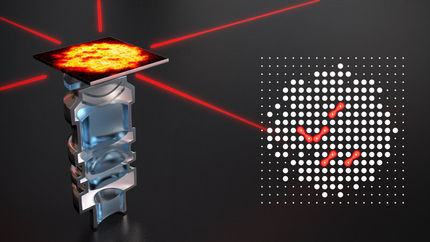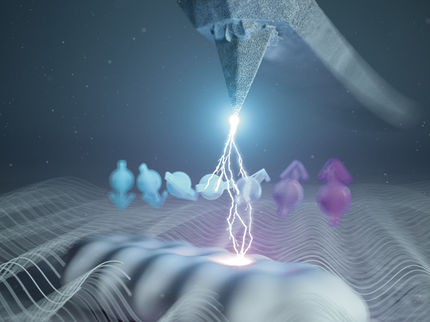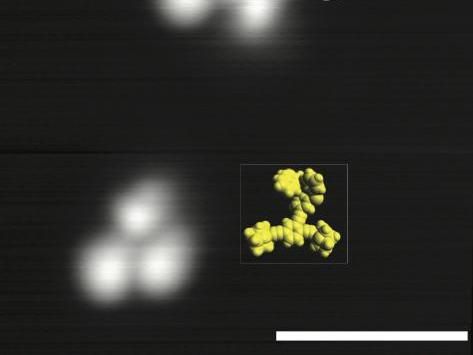In atomic propellers, quantum phenomena can mimic everyday physics
In molecules there are certain groups of atoms that are able to rotate. This movement occurs under the influence of random stimuli from the environment and is not continuous but occurs in jumps. It is generally believed that such jumps occur in a manner that is typical of classical objects, such as a fan blade prodded by a finger. Chemists from the institutes of the Polish Academy of Sciences in Warsaw have, however, observed rotations that follow the non-intuitive rules of the quantum world. It turns out that under the appropriate conditions, quantum rotations can very well mimic normal, classical rotation.
Chemistry is often presented as almost mechanical fun connecting atomic balls with sticks (bonds). Professor Slawomir Szymanski from the Institute of Organic Chemistry of the Polish Academy of Sciences (IOC PAS) in Warsaw is, however, certain that in reality much more exotic and non-intuitive phenomena of a quantum nature are responsible for some of the effects observed in molecules. He has for years been developing a model describing in quantum terms the jump rotations of whole groups of atoms in molecules. The theoretical work of Prof. Szymanski has just found further confirmation in experiments conducted at the Institute of Physical Chemistry of the PAS (IPC PAS) by a group led by Dr. Piotr Bernatowicz.
"In chemistry quantum mechanics is used almost exclusively to describe the motion of tiny electrons. Atomic nuclei, even those as simple as the nucleus of hydrogen made of a single proton, are considered too large and massive to be subject to quantum effects. In our work, we prove that this convenient but very simplistic view must finally begin to change, at least in relation to certain situations," says Prof. Szymanski.
Prof. Szymanski's quantum rotation model describes the rotation of atomic groups composed of identical elements, e.g. hydrogen atoms. The latest publication, completed in cooperation with Dr. Bernatowicz's group, concerns CH3 methyl groups. In their structure, these groups are reminiscent of tiny propellers: there are three hydrogen atoms around the carbon atom, spaced at equal intervals. It has been known for a long time that the methyl groups, connected by a carbon atom to the molecules, can make rotational jumps: all the hydrogen atoms can simultaneously rotate 120 degrees around the carbon. These rotations have always been treated as a classic phenomenon in which hydrogen 'balls' simply jump into the adjacent 'wells' which have just been vacated by their neighbours.
"Using nuclear magnetic resonance, we carried out difficult but precise measurements on powders of single crystals of triphenylethane, a compound of molecules each containing one methyl group. The results leave no room for doubt. The shapes of the curves we recorded, so-called powder resonance spectra, can only be explained by the assumption that quantum phenomena are responsible for the rotations of the methyl groups," says Dr. Bernatowicz.
The measurements of the rotation of the methyl groups by nuclear magnetic resonance required precise control of the temperature of the powdered substances. This is because the quantum nature of the rotation only becomes clearly visible in a narrow temperature range. When the temperature is too low, the rotation stops, and when it is too high, the quantum rotations become indistinguishable from the classical ones. The temperatures of experiments at the IPC PAS, in which the quantum nature of the rotations was clearly visible, ranged from 99 to 111 Kelvin.
A new picture of chemical reality emerges from this research. The CH3 group in the molecule is no longer a simple rotor composed of a carbon core and three rigidly attached hydrogen atoms. Its actual nature is different: in it no hydrogen atom occupies a separate position in space - what's more, each of them continually mixes in a quantum manner with the other two. The methyl group, although constructed of many atoms, under the right conditions turns out to be a single, coherent quantum being that does not resemble any object known to us from the everyday world.
A description of classical atomic rotator motion can be constructed using one constant measuring the average frequency of its jumps. It turns out that in the quantum model, there must be two such constants and they depend on the temperature. When the temperature rises, both constants take on a similar value and the rotations of the methyl group begin to resemble classical rotations.
"In our measurements we really observed the gradual transformation of the quantum rotations of the methyl groups into rotations difficult to distinguish from the classical ones. This effect should be appropriately understood. Quantum phenomena did not cease to function, but in a certain way imitated classical jumps," explains Dr. Bernatowicz.
Scientists from the IPC PAS and IOC PAS had already earlier confirmed the correctness of the quantum rotation model in experiments with methyl groups (among others in molecules of dimethyl triptycene, where these effects were accompanied by dynamic changes in the crystal lattice). However, predictions concerning the rotations of a much more complex atomic structure, the C6H6 benzene ring, await experimental verification.
"Our research is of a basic nature and it is difficult to talk here immediately about specific applications," notes Prof. Szymanski adding: "It is worth emphasizing, however, that quantum effects are considered to be extremely sensitive to the environment. Chemists and physicists assume that in very dense environments they are destroyed by the thermal movements of the surroundings. We observe quantum effects at relatively high temperatures, in addition in condensed environments: liquids and crystals. The results we obtain should therefore be a warning to chemists or physicists who like oversimplified interpretations."
The imitation of classical physics by quantum phenomena, in addition in a dense and relatively warm environment, is a surprising effect that should draw the attention of, among others, the constructors of nanomachines. By designing smaller and smaller molecular devices they must begin to realize that at a moment that is difficult to predict they may unwittingly move from the world of classical physics to the world of quantum phenomena. Under new conditions the operation of nanomachines could suddenly stop being as predictable as, for example, the mechanical watch.
































































